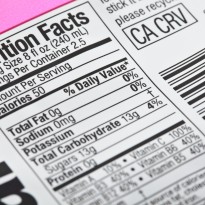What is required on a food label?
Posted on 15/03/2018 in Company News, by Jon

As a legal requirement on food packaging, food labels give customers important information about your product. They help customers make a purchase decision, store and use the product safety and protect them from any potential allergic reactions to some of the ingredients are used.
Food labels cover all products that are sold to customers directly, as well as food sold to cafes, restaurants and other catering establishments.
To make sure that food labels are safe, accurate and not misleading, there are a certain number of things that must be shown. So, what must you ensure that you include on your food label?
Depending on the food product that you’re selling and where it’s being sold, food labels have certain specific requirements. Certain products, like bottled water and honey, special rules and requirements apply. Generally, the basic requirements of any food label are:
1. Manufacturers name and contact details.
The manufacturer’s name and contact details required for customers to know where who made the product and who they can get in touch with if they have any problems or questions.
As well as a requirement, this information is a great way to reinforce your branding on your food labels.
2. The name of the product.
Although putting the name of the product seems obvious – it’s needed to let it’s needed to let your customers know exactly what it is they’re buying.
3. Description of a product.
The description is required on food labels to give customers a brief overview of the information they need to know about your product.
On your food labels, use this space to your advantage. As well as giving essential information, sell to your customers by giving them a reason to buy.
4. Ingredients
If you have two or more ingredients in your product (including any additives), then all your ingredients must be listed.
The ingredients need to be listed in order of weight, with the main ingredient listed first. If any ingredients have been highlighted or named in the food label or will be connected in the name by the customer, you will need to show the percentage of these ingredients.
For any packaged food over 5g or 5ml, or any herbs and spices, you need to list the net quantity of the ingredients. For foods in a liquid of ice glaze, list the drained net weight.
Alcoholic drinks will also need to include the strength of the beverage.
Listing ingredients on food labels also helps customers avoid any allergens or ingredients that may conflict with their dietary requirements. If your product contains any common allergens, it’s important that you list these in a way that stays out, such as a different font, style or colour.
5. Cooking instructions
Cooking instructions are needed to let your customer know the best way to cook your product. This is required on food labels to protect people from becoming ill by eating food that isn’t cooked or prepared properly, which could damage your brand and reputation.
Ensure your customers are only experiencing the best from your products by including cooking instructions.
6. Shelf life.
To increase food safety and reduce waste, the durability of your product needs to be shown in two ways: the best before date and the use by date.
The best before date tells the customer when they should consume the product by to have the best quality, while the use by date explains at which date that foods will become unsafe to consume.
If the dates are not printed directly on the food label, then you need to leave information on where to find it, such as on the bottom of the product.
As well as durability, food labels should also give instructions on the best way to store the product, increasing safety while ensuring your customers only get the best.
7. Place of origin
The place of origin is required for all meat, fish, honey, olive oil and wine products, as well as any fruit and vegetable imports from outside the EU.
Outside of these products, printing the country of origin is a great idea on food labels to avoid any misleading confusion. For example, if a pizza label uses images of Italy but is made in the UK, this can mislead the customer and would be required to show the country of origin.
8. Necessary warnings
If your product contains certain ingredients, such as caffeine, raw milk or sweeteners, then your food label needs to show a warning label. The full list of warning labels that are needed can be found here.
Conclusion
As well as all including essential information about the product, food labels must be clear and easy to read and understand, visible, permanent and not misleading.
With over 40 years of experience at Soabar, we can help you create food labels that not only hit all the legal requirements but also look great.
Great designed food labels also are excellent POS tools that can strengthen brand awareness, remind customers of the quality of your product let your stand out amongst heavy competition. With our own in-house artwork department, we also offer a fully bespoke design service to create the right label that matches your brand.
With a range of different sizes, colours, quantities, materials and the ability to easily customise each label with barcodes, dates and other important variable information, we’ll help you create the perfect label to suit your business.
Made to be long-lasting, our food labels are designed to withstand many conditions, including fridges or freezers, giving you the peace of mind they won’t let you down.
Ready to create your own food labels? Get in touch with a member of our team today.

